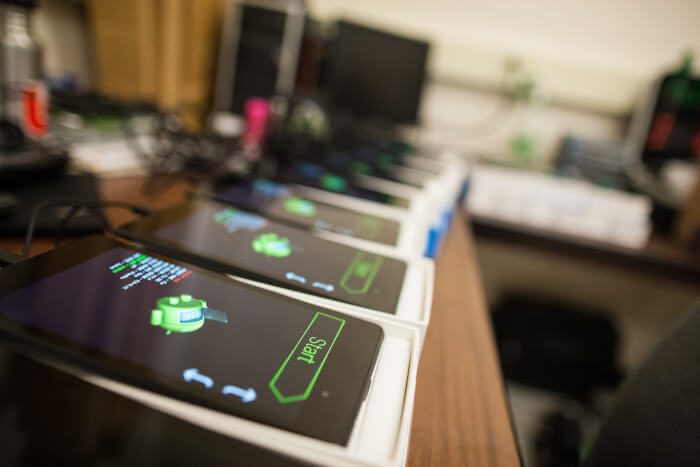I tend to have a love-hate relationship with technology. On one hand, I enjoy the old-school pencil and paper, face-to-face communication, and less screen-related interaction. On the other hand, there are plenty of forms of technology I enjoy, rely upon, and find extremely convenient.
I have the same hesitancy with new technology in education. Rather than embrace every new trend wholeheartedly without question, as a teacher and parent, I approach things more cautiously. Will it deprive teachers of any personal one-on-one time with their students? Will it enhance what teachers are already doing? And will it provide the students with a more complete grasp of the subject?
With this evaluative approach in mind, here are seven examples of innovative educational technologies that are making their way into the classroom setting.

1. Digital readers and tablets
Increasingly, schools are looking to replace the bulkier hard-copy textbooks with digital ones that are accessible via a tablet.
Pros
- They eliminate the need for students to carry around a heavy backpack full of books.
- They provide a centralized, accessible place for all reading materials.
- The regular updates of digital content eliminates the cost of purchasing new textbook editions every few years.
- Apps added to tablets can meet the educational needs of the students and provide for more personalized learning opportunities.
Cons
- to fully implement, schools would need to provide a tablet to every student and have a system in place for dealing with lost, damaged, or stolen assets. (However, a BYOD policy may be a feasible and more cost effective alternative.)
- It eliminates the option for students to dramatically chuck their math book across the room when they get frustrated with it. (I feel that loss on a personal level.)

2. 3D printing
3D printing has already seen an impressive application in the world at large. According to Forbes, 3D printers have been able to create anything from car parts to artificial organs. In the classroom setting, 3D printing can create hands-on models that students can investigate and interact with. For example, students could learn about the geography of an area by observing a 3D map of it.
Pros
- 3D printing reaches both visual and kinesthetic learners.
- It engages the students and gets them curious.
- It reduces the time teachers need to spend on creating their own models (e.g., for a science class).
Cons
- Barely any. One might argue that 3D printing technology means students won’t get to create their own physical models, but there’s nothing suggesting that the two can’t coexist.

3. Virtual reality
Technology for virtual reality, augmented reality, and mixed reality is rapidly developing. One of the primary uses for this technology in the classroom is to take students on virtual field trips to places otherwise inaccessible. For example, a student could take a virtual field trip to ancient Egypt or to the bottom of the ocean. One provider of this technology is Nearpod VR.
Pros
- It provides engaging, real-life experiences that would otherwise be harmful or inaccessible.
- Appeals to visual learners who like to see and experience things instead of merely reading about them.
Cons
- Students using virtual reality may develop a lack of spatial awareness in the real world. In other words, they could hit or run into something in the real world while immersed in the virtual one.
- Motion sickness can develop in some students due to their eyes sensing movement while their body does not.

4. Gamification
Students learn better when they’re having fun. The use of gaming in the classroom applies this concept by tying together the fun part of play with the content and concepts that students must learn.
Pros
- It increases student engagement.
- It creates enthusiasm for the lesson.
- It provides immediate feedback.
Cons
- Not every fun game is effective at teaching a given concept. Not every game that is effective at teaching the concept is fun, either.
- It takes time and training to learn how to effectively use games for learning. However, platforms like Classcraft use gaming technology and offer training for those who want to learn how to better implement it in their classrooms.

5. Cloud technology
The cloud hosts apps and services on the internet instead of being on a user’s computer. It enables information to be stored, shared, and accessed on any device that’s connected to the internet. In education, the cloud is used to store and share digital textbooks, lesson plans, videos, and assignments. It’s also used to give students the opportunity to chat live with their instructors and other classmates. In a related vein, cloud technology is enabling a new educational model known as ‘flipped classrooms’ in which students can watch a lecture before class and spend the class time engaged in discussion, group work, and analytical activities.
Pros
- It reduces the chances of homework getting lost between school and home.
- It reduces the need for students to carry heavy textbooks.
- It enables students to easily access information from any device connected to the internet.
- It enables quick and easy access to the teacher through live chat options.
Cons
- To fully adopt the cloud, schools would need to somehow ensure that every student has adequate access to the internet.
- Security. Although pretty much every network on the cloud has a security system in place to protect its information, hacking can be a concern.

6. Artificial intelligence
AI is making its way into the educational sphere by means of automating grading and feedback and providing personalized learning opportunities. For more information about the use of AI in the classroom, check out this article.
Pros
- It can save the teacher time by doing the grading and giving feedback on their behalf.
- It provides greater insights into a student’s learning patterns.
Cons
- Teachers can learn a lot about a student’s learning patterns by doing the grading themselves.
- There’s a personal element of care when a teacher gives personalized feedback (rather than letting a machine generate one).

7. Mobile technology
Rather than banning cell phones and other mobile devices from use during class, some schools are incorporating this technology into the learning process through educational apps.
Pros
- The wide variety of available apps offers the opportunity for students to engage in their own learning process.
- Educational apps provide the opportunity to personalize learning to each student.
Cons
- Not every student possesses a mobile device, and not every parent is comfortable with their child having one.
- To really utilize this technology, schools would need to make sure that every parent is onboard and that every student has access to some sort of mobile device.
Look for these innovative uses of educational media and technologies
Technological advancements are truly impressive. We should accept that this is the world our students are growing up in and provide opportunities to expose them to these wonderful developments. However, each new technology should be carefully evaluated and used as a tool to enhance the personal element in the teaching process, not to completely replace traditional learning methods.
Photo credit: Google
Technology Integration


